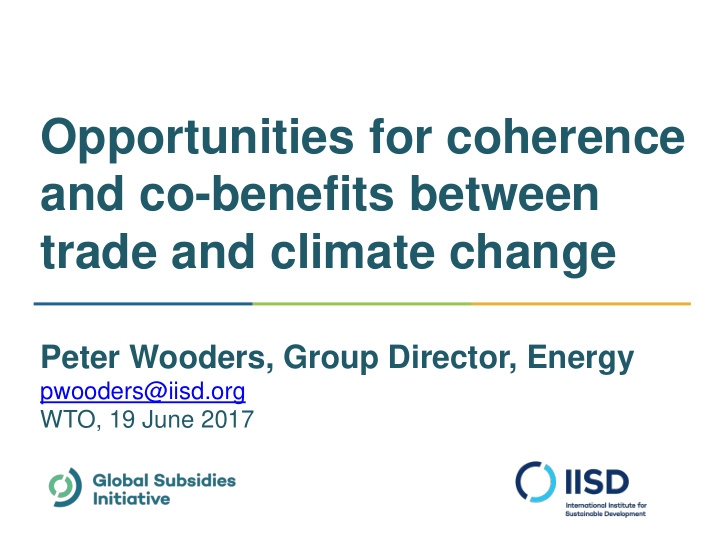



Opportunities for coherence and co-benefits between trade and climate change Peter Wooders, Group Director, Energy pwooders@iisd.org WTO, 19 June 2017
3 policies with a major potential impact on GHG emissions – and a role for trade 1. Fossil fuel subsidy reform 2. Standards, labelling & government procurement 3. Supporting the low carbon transition
Consumer subsidies ($325 billion in 2015, IEA data) by energy type Categories of consumers: private sector, public sector, households • IEA=most-quoted source • 40 developing & emerging economies • IEA data, assumptions • IEA definition (‘subsidies change prices’) • Opaque calculations • Benchmarks based on global fuel market prices • Non-application of ‘normal’ tax a subsidy Reform: 6-8%+ GHGs •
Consumer subsidies (at their highest in 2013, IEA data) by country Sources: IEA (2014), p. 323
Producer subsidies ($70 billion on annual average in G20 countries) by energy type • Basis: OECD inventory of support measures • OECD + BRICSAM • Producer & consumer • Inventory of individual polices & measures • Definition ~ ASCM • Data only from govt. sources ( conservative) • Semi-official? (OECD members can object) • >$100bn globally (GSI) Reform: 2-3%+ GHGs • Sources: GSI & ODI (2017) based on OECD (n.d.)
Subsidies to fossil-fuel consumption: what trade effects? • Markets that are affected range from nitrogenous fertilisers (made from natural gas), to petrochemicals , to refined metals, such as aluminium . • Less talked about are the effects of fossil-fuel consumption subsidies on markets for renewable energy , for electrified transport, and for goods and services related to improving energy efficiency . • Although many of the subsidies benefit transport fuels (which affect markets for electrified buses and trams , for example), some also reduce prices for fossil-fuel based electricity, which makes it difficult for solar or wind-based power to compete. • These effects are amplified by the generally higher import tariffs charged on renewable-energy tech- nologies than on petroleum products, natural gas or coal. Trade and Agriculture Directorate | Organisation for Economic Co-operation and Development (OECD) | www.oecd.org/tad | tad.contact@oecd.org
Subsidies to FF production: what trade effects? • Analysts are only starting to examine the trade effects of subsidies to FF production. • Domestically, some of the subsidies may simply be enriching existing producers , but not materially changing their output levels. • Others, however, may be affecting the rate and timing of development of new fields . • According to a study by the SEI, “at recent oil prices of $50 per barrel, subsidies push nearly half of yet-to-be-developed oil into profitability, potentially increasing U.S. oil production by almost 20 billion barrels over the next few decades.” Trade and Agriculture Directorate | Organisation for Economic Co-operation and Development (OECD) | www.oecd.org/tad | tad.contact@oecd.org
Five Ways to Address Fossil Fuel Subsidies at the WTO* Promote Capacity Building Change Enhance Existing Rules Transparency Provide Introduce Interpretation Pledge, Report of Rules and Review *Noting need to address special circumstances of developing countries and to protect the poor and vulnerable
Standards and labelling • Climate Change Mitigation benefits = 7-15% of total global BAU (business as usual) GHG emissions (various scenarios) • Currently, product policy-settings are only weakly internationally aligned, with some notable exceptions (e.g. Energy Star for IT) Win-win : standards harmonization increases trade flows, makes it easier for exporters to penetrate foreign markets
Government procurement • Procurement typically 45-65% of government expenditure • 13-17% of GDP in OECD countries • Higher in many developing countries, especially if state-owned enterprises are included Can set practice and standards for wider market • Agreement on Government Procurement (Plurilateral: 18 Members + EU) • Not extended beyond signatories; focus on fair tendering Within GPA, WTO rules don’t act as a barrier to green procurement (UNEP/IISD Handbook, 3 rd Edition) • Article 68(1)(b) of the Directive 2014/24/EU on life-cycle costing • relevant costs can also be "cost imputed to environmental externalities" linked to a product, service, or work during its life cycle, provided the monetary value can be determined and verified
Supporting the low carbon transition: External costs to air are largely not captured Source: EDF-IETA
Supporting the low carbon transition: EGA (precedent+?), Clean Energy Subsidies? Clean energy subsidies justifiable as a second-best solution list of non- actionable subsidies Allow support to local Renewable Energy Manufacturing Traffic light system?
Supporting the low carbon transition: Extension of trade in (green) services Swedish National Board of Trade, 2014 • Manufacturing firms becoming more and more dependent upon services to stay competitive • Synergistic relationship between goods & services treat together • Mode 3 (commercial presence), Mode 4 (movement of natural persons) are key OECD Trade & Env. WP 2017/02 • Division 94 of UN CPC too narrow • Environmentally-related services: • Constrained in many countries • Need better data (home & abroad)
Supporting the low carbon transition: the challenge of energy & intensive sectors The Energy Sector and Energy-Intensive Industry are major GHG emitters – common challenges globally • Governments across the world are concerned by competitiveness , and by leakage if they impose relatively stringent environmental policies • Key sectors of concern typically: Steel, Chemicals, Cement, Non- Ferrous Metals, Paper & Pulp; and Electricity Generation (cost) • Energy and energy-intensive industries are large point sources of employment , sometimes in remote or deprived areas • They can also be major contributors to tax revenues, and may hold significant political power or symbolism • Step-change innovation needs wide cooperation?
Recommend
More recommend